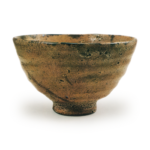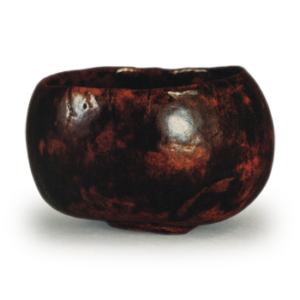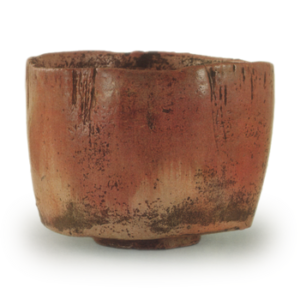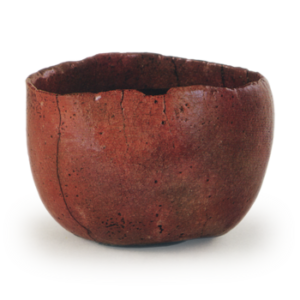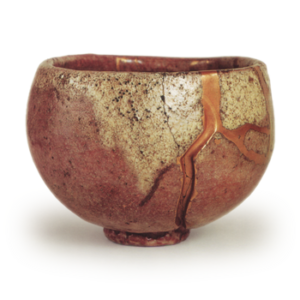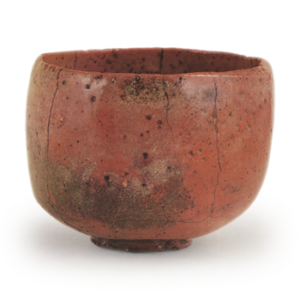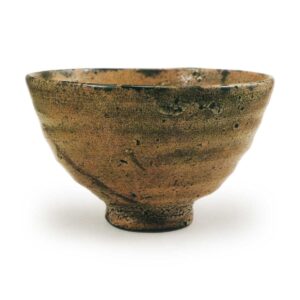
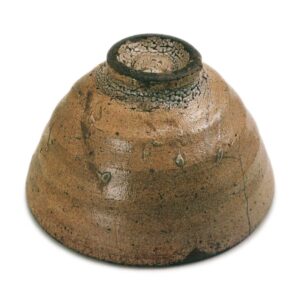
Height: 8.5-8.7cm
Diameter: 14.7-14.9cm
Outer diameter of foot ring: 5.3cm
Height of foot ring: 1.8cm
This is a singular bowl that was passed down in the Matsudaira family of Unshu and was a favorite of Lord Fumai. The shape and color are as they should be, but the scenery inside and outside the foot ring is particularly interesting, and the single line of lathe marks that encircle the body are also impressive. Compared to the famous Kizaemon well, the same Oido teacup favored by Fumai is more stylish and has a stronger, more individualistic taste.
The part where the glaze has been scraped off on the side of the foot ring is covered in a thick layer of glaze, and the glaze has burst open in large areas, revealing the clay beneath by chance. This is not the result of the peeling of the kaaragi glaze after firing. The color is the same as that of the surviving examples, and it is a little darker, but the sharp traces of the spatula used to scrape off the rough clay surface are still clearly visible, and there is something of the sharpness of a sword blade to be seen here.
While the shape is wide and deep, with a relaxed appearance, the bowl-like exterior is rather smooth and gentle, and the only thing that stands out is the horizontal band that runs clearly across the smooth exterior. In contrast to this quiet composure, the foot and the surrounding waist are full of vitality and excitement. As with many famous bowls from the Ido area, the strongly carved bamboo-jointed foot has a beautiful kaaragi finish, and it seems to be able to express a beauty of dynamism.
First, a small cap is protruding from the bottom of the foot ring, and the scraping lathe has been reversed around this, but the scraper marks remain strongly and clearly from the outside of the foot ring to the waist, and the whorl-shaped arc lines that were scraped off in one go are particularly sharp. The well’s beauty seems to be in the brilliant contrast between the stillness and movement centered around the footring, and the wonderful inflection.
The glaze is a light loquat color, and is smoothly covered with fine cracks that are either dark or faintly visible. In contrast, the inside is a slightly stronger loquat-colored glaze with a generous amount of glaze, which also shows a pleasing glaze tone. The beauty of the transformation of the plum-blossom skin around the foot ring and its ingenious use does not require much explanation, and we can only admire the ingenuity of nature. There are five marks on the foot ring, but there are none on the inside. In addition, there are small patches of black lacquer here and there around the edges, and there are several cracks of various sizes visible. There are relatively few small holes that look like they have been made with a needle.
The box is black lacquered, and the lid is inscribed with the characters “Tsunekana” in red lacquer, but it is not clear who the inscription is from.
In the upper section of the Unshu Zocho (a book of records of the Matsudaira family’s possessions), it is written “Oido Tsunekana, Bokusuke and Mosai, 100 ryou in gold”, and it was a possession of the Matsudaira Fumai, and was kept secret in the Matsudaira family for a while, but it was given as a gift to Takahashi Nomizu, a retainer of the Matsudaira family, in gratitude for his kindness, during the time of Matsudaira Naoyori. A letter of commendation from Naoyori is attached.

